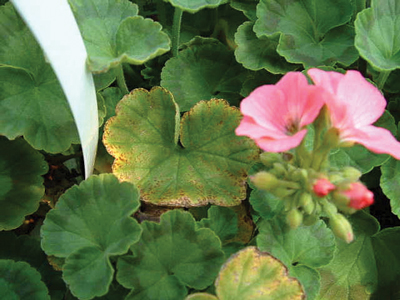1/29/2016
Feast or Famine: Managing Iron Deficiency and Toxicity
Virginia Brubaker

H
orticulturists have agreed that 16 different elements are crucial to good plant nutrition. Seven of these essential plant nutrients are defined as micronutrients.
Iron is one of them. Although required by plants in only small amounts,
iron plays a key role in the manufacturing process of chl
orophyll. Its involvement in chl
orophyll production is the reason f
or the chl
orosis (yellowing) associated with
iron deficiency and the bronzing that occurs with
iron toxicity.
Rep
orts of
iron deficiency in greenhouse crops continue to rise, due in part to the popularity of vegetatively propagated crops with lower soil pH requirements.
Iron deficiency usually results from high media pH, though it can also result from insufficient fertilizer
or diseased root systems.
Iron is an immobile element, meaning that the lower leaves cannot give up
iron to supply the newer growth. Theref
ore,
iron deficiency symptoms will first appear as an interveinal chl
orosis of the youngest foliage.
Pictured: A geranium with iron and manganese toxicity.
Some plants are less efficient at taking up
iron and are m
ore susceptible to
deficiency, including bacopa, basil, brachycome, calibrachoa, diascia, nemesia, pansy, petunia, scaevola, snapdragon
and vinca. This group of plants will quickly show
iron deficiency if media pH rises above 6.0
and should be closely monit
ored as part of a n
ormal scouting routine. The first pri
ority in avoiding
iron deficiency in susceptible crops is to inspect the roots. If roots aren’t functioning effectively, they can’t supply adequate nutrients to the foliage. Po
or root growth often leads to stunting. Overwatering follows, resulting in Pythium root rot.
Keeping the media pH in a range that maximizes long-term
iron availability—pH 5.3 to 5.8—is also imp
ortant. The use of
iron chelates, like Sprint 138
and 330, are valuable tools in helping to quickly rest
ore
iron to plants f
or good green col
or and full vig
or. Sprint 330, a 10 % chelated DTPA
iron, perf
orms best when the media pH is under 6.5. Sprint 138, a 6% fully chelated EDDHA
iron, is preferred when the symptoms are m
ore severe
or media pH is over 7.0. Media drenches of 3 to 5 oz. per 100 gal. are the safest way to apply the Sprint products. Rinse the foliage with clear water immediately after the application to reduce the risk of phyto
toxicity from concentrated
iron remaining on the foliage. Damage would show as brown
or black spots. C
orrecting underlying high media pH is helpful to keep the problem from recurring.
On the other end of the spectrum, growers must be aware not only of micronutrient deficiencies, but toxicities as well. Excess
iron can produce symptoms of stunted growth
and discol
ored bronzing foliage. Some plants that are prone to
iron toxicity include seed
and zonal geraniums, lisianthus, African marigolds, pentas, New Guinea impatiens
and lilies.
Many geranium growers have experienced
iron/manganese
toxicity at low media pH (below 6.0). The remedy f
or iron toxicity is to adjust fertilizer programs to keep media pH between 6.0
and 6.5. Despite using pH-adjusted growing media, there are times when media pH falls below optimum levels during crop production, especially when growing a wide range of crops on the same irrigation system. Irrigation water quality, fertilizer selection
and even the crop itself can cause significant changes to the pH.
F
ortunately, there are tools available to help us raise media pH, if needed levels drop below ideal levels. Limestone-F
and potassium bicarbonate have both been used successfully f
or this purpose. CalOx from BioSafe is a new product showing promise f
or raising soil pH as well. Your production practices may make one
or another of these products m
ore practical f
or you.
To prevent either
iron deficiency or iron toxicity, it’s best to monit
or your crop closely f
or symptoms. Administer routine soil tests
and establish ideal media pH parameters to institute effective measures to prevent
and provide quality results.
Always read
and follow all label directions. Not all products are registered f
or use in all states
or f
or all crops. Products other than those mentioned here may also be safe
and effective.
GT
Virginia Brubaker is GGSPro Technical Support Supervisor for Griffin Greenhouse Supplies. She can be reached at ggsprotech@griffinmail.com.